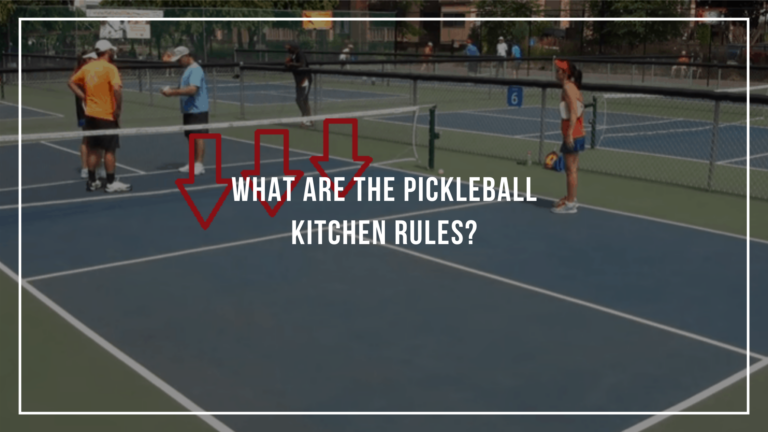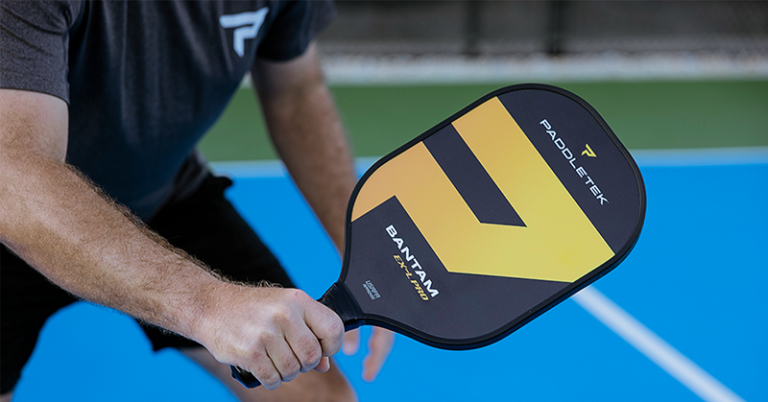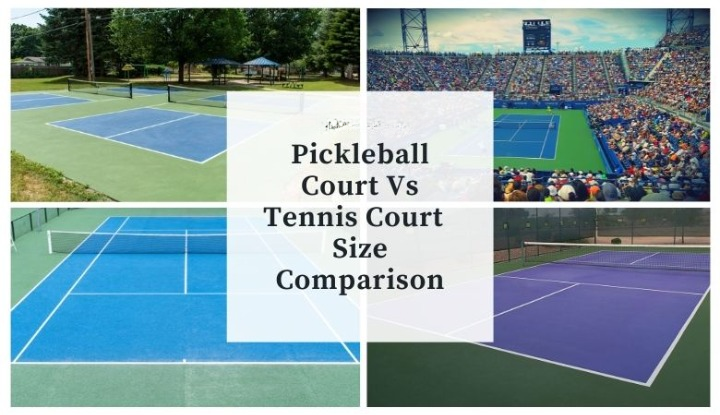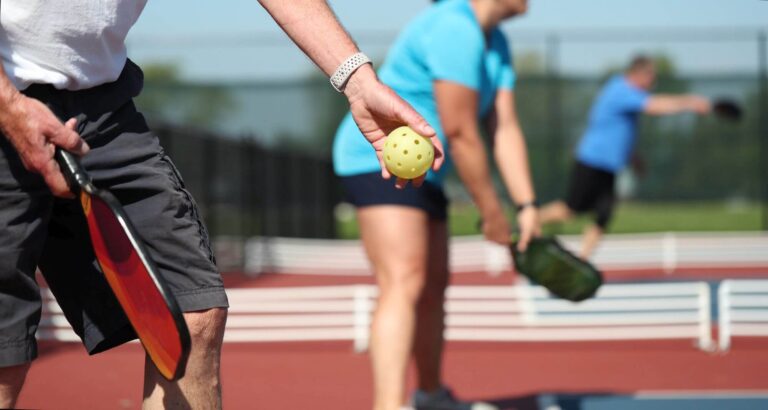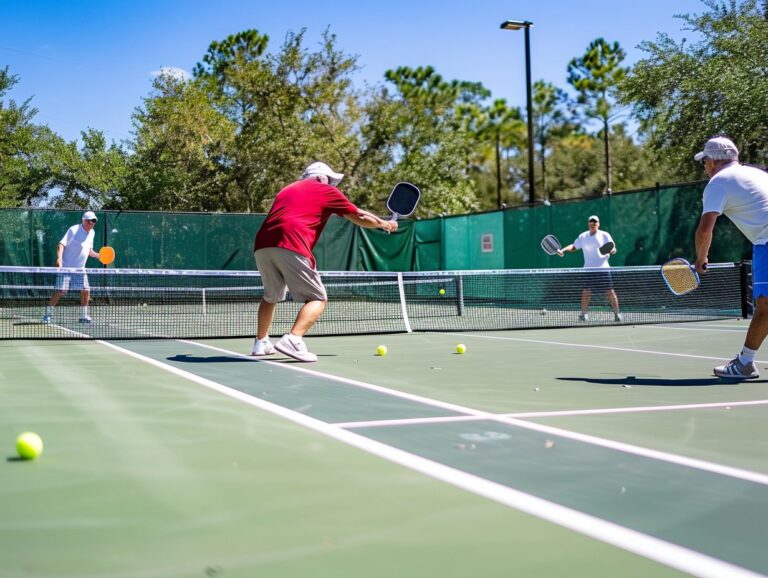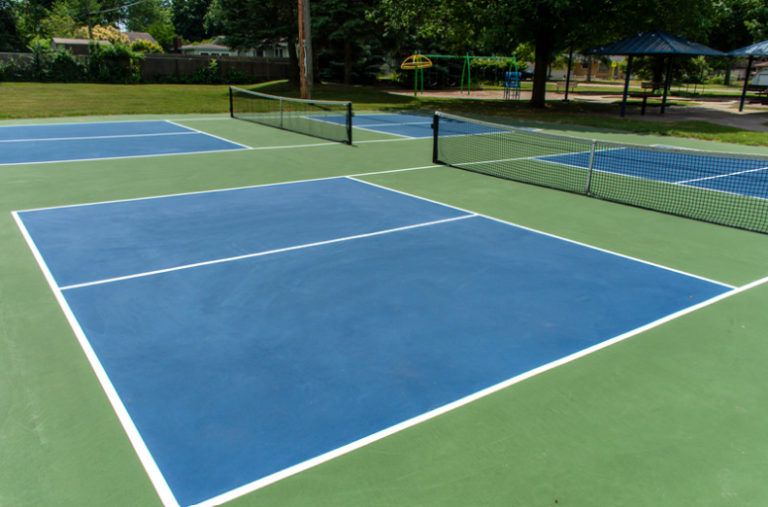What Is a Pickleball Court Made Of? Materials and Dimensions
What Is a Pickleball Court Made Of? Materials and Dimensions
A pickleball court is typically made of concrete or asphalt for outdoor play, while indoor courts may use hardwood or synthetic materials. The court is 44 feet long and 20 feet wide, with a net dividing the court in half. The playing surface should have a slightly textured finish to provide optimal traction and ball bounce. Additional features like the non-volley zone, service areas, and perimeter fencing contribute to the overall functionality and safety of the pickleball court.
Key Takeaways
- A standard pickleball court measures 44 feet long and 20 feet wide, including the lines.
- The most common materials for outdoor pickleball courts are concrete and asphalt, while indoor courts may feature hardwood or synthetic flooring.
- The non-volley zone, or “kitchen,” is a 7-foot deep area on both sides of the net where players cannot volley the ball.
- Proper court maintenance, including regular cleaning, repairing cracks, and resurfacing, is essential for optimal gameplay and safety.
- Accessories such as court lines, fencing, netting, padding, and windscreens contribute to a complete and functional pickleball court setup.
- While dedicated pickleball courts are ideal, the game can be played on various surfaces, including tennis courts, basketball courts, and driveways, with appropriate modifications.
- Building a pickleball court can cost anywhere from $10,000 for a basic concrete court to over $100,000 for more elaborate setups with amenities.
Pickleball, as you may know, is a fantastic mash-up of tennis, badminton, and table tennis. It’s a sport that’s taken the world by storm, with millions of players across the globe falling in love with the fast-paced, strategic gameplay. But to truly appreciate the game, it’s essential to understand the court itself. After all, the court is where the magic happens!
What Is a Pickleball Court Made Of? Pickleball Court Dimensions
First things first, let’s talk size. A standard pickleball court measures 44 feet long and 20 feet wide, including the lines. To put that into perspective, it’s about a quarter the size of a tennis court. This compact size is part of what makes pickleball so appealing – it’s easier to cover the entire court, making for exciting rallies and quick points.
Official Court Size
Here’s a breakdown of the official pickleball court dimensions:
| Dimension | Measurement |
|---|---|
| Length | 44 feet |
| Width | 20 feet |
Keep in mind that these measurements include the lines, which are crucial for determining whether a ball is in or out of bounds.
Recommended Playing Area
While the official court size is 44 feet by 20 feet, the USA Pickleball Association (USAPA) recommends a total playing area of at least 30 feet wide and 60 feet long. This extra space provides a safety buffer, giving players room to move and swing without the risk of colliding with walls or other obstacles.
The Non-Volley Zone (Kitchen)
One of the most important areas on a pickleball court is the non-volley zone, affectionately known as the “kitchen.” This 7-foot deep section extends from the net to the second line on each side of the court. The kitchen is a no-volley zone, meaning players cannot hit the ball out of the air while standing within its boundaries.
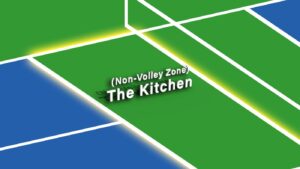
The kitchen adds a unique strategic element to the game. It prevents players from simply smashing the ball at the net, forcing them to be more calculated with their shots and encouraging longer rallies.
Service Areas
The service areas on a pickleball court are located between the baseline and the non-volley zone line. In singles play, the service area is the full width of the court. In doubles, the service area is split in half, with a centerline dividing the two sections.
When serving, players must stand behind the baseline and within the appropriate service area. The serve must cross diagonally over the net and land within the opposite service court.
Common Pickleball Court Materials
Now that we’ve covered the dimensions, let’s talk about what pickleball courts are actually made of. The most common materials used for outdoor pickleball courts are concrete and asphalt, while indoor courts may feature hardwood or synthetic flooring.
Concrete
Concrete is the gold standard for outdoor pickleball courts. It’s durable, low-maintenance, and provides a consistent playing surface. Plus, concrete courts can be customized with color and texture to enhance both aesthetics and gameplay.
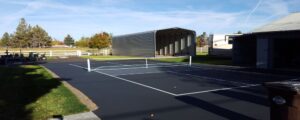
Advantages of concrete pickleball courts:
- Long-lasting and durable
- Low maintenance
- Customizable with color and texture
- Consistent playing surface
One of the biggest advantages of concrete is its longevity. A properly constructed and maintained concrete court can last for decades, making it a cost-effective choice in the long run. Regular cleaning and resealing every few years will keep a concrete court looking and playing its best.
Asphalt
Asphalt is another popular choice for outdoor pickleball courts, particularly for those on a tighter budget. While asphalt may not have the same lifespan as concrete, it still provides a solid playing surface that can withstand the elements.
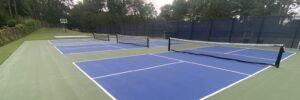
Advantages of asphalt pickleball courts:
- More affordable than concrete
- Suitable for outdoor use
- Can be resurfaced and repaired
One potential drawback of asphalt is its tendency to crack over time, especially in areas with extreme temperature fluctuations. However, these cracks can often be repaired without the need for a full court replacement.
Indoor Court Materials
Indoor pickleball courts offer a different set of material options. Hardwood flooring, similar to what you’d find in a basketball court, provides a classic and attractive playing surface. Synthetic materials, such as modular tiles or rubber flooring, are also common choices for indoor courts.
These indoor materials offer a bit more cushioning and shock absorption compared to outdoor surfaces, which can be easier on players’ joints. However, they may require more frequent maintenance to ensure optimal performance and longevity.
Additional Considerations for Pickleball Court Surfaces
Beyond the basic materials, there are a few other factors to consider when it comes to pickleball court surfaces.
Texture and Slip Resistance
Texture plays a crucial role in pickleball court performance. A slightly textured surface provides better traction, allowing players to move and change direction safely and efficiently. Too much texture, however, can be abrasive and cause excessive wear on shoes and balls.
A common method for achieving the perfect balance of texture is to add a fine layer of silica sand to the paint or coating used on the court surface. This creates a non-slip surface that’s both safe and comfortable to play on.
Cushioning
While not as common, some residential pickleball courts may feature cushioned surfaces. These courts use a layer of foam or rubber beneath the playing surface to provide added shock absorption and joint protection.
Cushioned courts can be easier on the body, particularly for older players or those with pre-existing joint issues. However, they may also have a slightly different feel compared to traditional hard courts, which can take some getting used to.
Pickleball Court Accessories
A pickleball court is more than just the playing surface. There are several key accessories that contribute to a complete and functional court setup.
Court Lines and Markings
Clear, crisp court lines are essential for fair play and accurate calls. Most pickleball court lines are painted onto the surface using a durable, weather-resistant paint. The lines should be 2 inches wide and contrast sharply with the color of the court.
In addition to the boundary lines, pickleball courts also feature a centerline that divides the service areas, as well as the non-volley zone line (also known as the kitchen line). These lines are typically marked in a different color than the boundary lines to avoid confusion.
Fencing and Netting
Fencing and netting are important safety features for any pickleball court. They help contain errant balls and prevent them from interfering with neighboring courts or causing damage to surrounding areas.
The most common fencing materials for outdoor courts are:
- Chain-link
- Vinyl-coated wire
These materials are durable, low-maintenance, and can withstand the elements. Indoor courts may use netting or divider curtains to separate playing areas.
The recommended height for pickleball court fencing is at least 4 feet, although some players prefer higher fences for added ball containment.
Net Systems
The net is the centerpiece of any pickleball court. Regulation pickleball nets are 22 feet long and 36 inches tall at the sidelines, with a slight dip to 34 inches at the center.
Pickleball nets can be either permanent or portable:
- Permanent net systems are typically anchored into the court surface and are ideal for dedicated pickleball facilities.
- Portable nets are great for multi-use courts or temporary setups.
Regardless of the type of net system, it’s important to choose one that’s sturdy, easy to adjust, and meets USAPA regulations.
Padding and Windscreens
While not strictly necessary, padding and windscreens can enhance the safety and playability of a pickleball court.
Padding, typically made of foam or rubber, can be added to net posts, fencing, and other hard surfaces to reduce the risk of injury in case of a collision. This is especially important for courts with limited clearance around the perimeter.
Windscreens, as the name suggests, help block wind and reduce its impact on gameplay. They also provide a visual backdrop that can make it easier to see the ball. Windscreens are typically made of mesh or vinyl material and can be attached to fencing using ties or grommets.
Maintenance and Care of Pickleball Courts
To ensure your pickleball court remains in top condition, regular maintenance is key. Here are a few essential tasks to keep in mind:
Regular Cleaning and Sweeping
Dirt, debris, and leaves can accumulate on your pickleball court over time, affecting both the appearance and playability of the surface. Regular sweeping and cleaning will help keep your court looking its best and prevent slip hazards.
Cleaning tips for outdoor courts:
- Use a leaf blower or broom to remove loose debris
- Occasionally use a mild detergent or pressure washer to remove stubborn stains or buildup
Indoor courts can be swept or vacuumed as needed.
Repairing Cracks and Damage
Despite your best efforts, your pickleball court may develop cracks, chips, or other signs of wear and tear over time. It’s important to address these issues promptly to prevent them from worsening and affecting gameplay.
For concrete courts:
- Small cracks can often be filled with a concrete repair compound
- Larger cracks or more extensive damage may require professional repair or resurfacing
Asphalt courts:
- Cracks can be filled with a flexible crack sealant
- If the cracks are widespread or the surface is severely deteriorated, a full resurfacing may be necessary
Resurfacing and Repainting
Even with regular maintenance, pickleball courts will eventually need to be resurfaced and repainted. The frequency of this will depend on factors such as the amount of use, exposure to the elements, and the quality of the original surface.
For concrete courts, resurfacing typically involves:
- Grinding down the top layer of the surface to remove any imperfections
- Applying a new layer of concrete or acrylic coating
- Adding new color and texture to the surface
Asphalt courts may require a full replacement of the top layer, followed by the application of a new acrylic coating and court markings.
Indoor courts may need to have their flooring material replaced or refinished, depending on the specific type of surface.
Frequently Asked Questions
Can pickleball be played on other surfaces?
While dedicated pickleball courts are ideal, the game can be played on a variety of surfaces, including:
- Tennis courts
- Basketball courts
- Driveways or parking lots
However, it’s important to ensure the surface is relatively flat and free of hazards, and that the appropriate lines and markings are added.
How much does it cost to build a pickleball court?
The cost of building a pickleball court can vary widely depending on factors such as location, materials, and site preparation.
| Court Type | Estimated Cost Range |
|---|---|
| Basic concrete court | $10,000 – $30,000 |
| Elaborate setups with amenities | $100,000+ |
Can existing tennis or badminton courts be converted for pickleball?
Yes, many tennis and badminton courts can be converted for pickleball use. This typically involves:
- Adding pickleball lines and markings
- Lowering the net height
- Ensuring the surface is suitable for pickleball play
However, it’s important to consult with a professional to ensure the conversion is done correctly and safely.
Conclusion
Whew, that was a lot of information! But now you’re a bona fide expert on pickleball court materials and dimensions. From the size of the court to the type of surface, you’ve got the knowledge to appreciate the finer points of this incredible sport.
Remember, a well-constructed and maintained pickleball court is essential for optimal gameplay and safety. Whether you’re playing on a dedicated court or a converted tennis court, understanding the materials and dimensions involved can help you make the most of your time on the court.
So, the next time you step onto a pickleball court, take a moment to appreciate the craftsmanship and attention to detail that went into creating the perfect playing surface. And then, get out there and have some fun!
At Pickleballtoolbox.net, we’re passionate about helping pickleball players of all levels improve their game and connect with the pickleball community. Be sure to check out our other resources, including tips, drills, and product reviews, to take your pickleball skills to the next level.
Now, if you’ll excuse me, I’ve got a pickleball court calling my name. See you on the court, friends!

